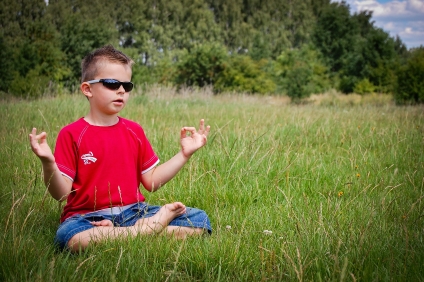What Is Mindfulness for Children?

By Donna K. Freeman
Mindfulness means “the awareness that emerges through paying attention on purpose, in the present moment, and nonjudgmentally to the unfolding of experiences moment by moment.” (Jon Kabat-Zinn) It is an active process involving staying aware of the external environment and the internal bodily sensations in the present moment without judgment, positive or negative.
Children live in a world of being told what to do: what time to wake up, what to eat, where and when they have various activities, such as school, sports, music lessons, etc. This can lead to going through the motions of living without conscious awareness. For example, if you ask them what they ate for lunch they may not be able to tell you. This in not simply because of poor memory, but more likely because they were not paying attention at the time.
Children are often much closer to their experiences than adults. Watch an infant experience anything for the first time; they look at it, touch it, feel it on their face, taste it. Every experience is fresh and new. They live in the moment reacting emotionally and immediately to a stimulus, then moving on to the next experience.
However, children also exists on auto-pilot, are easily distracted, are forgetful, lack concentration, have poor self-control and often do not understand themselves or the world. Mindfulness exercises address these concerns and can assist children in living with attention and awareness of themselves and their environment.
Keeping the needs and abilities of children in mind is key when adapting mindfulness exercises to various age groups. Children learn through concrete activities with clear, descriptive instructions. They also enjoy engaging their imaginations and creativity. And don’t forget the power of humor or the need for play.
Be sure to start with brief activities which will lead to success. Beginning with a five minute focus activity will be better than a 15 minute seated meditation.
Like all activities, mindfulness training improves with practice. As they learn mindful techniques, children can practice independently in everyday life: as they walk, as they eat, as they play. Purposefully engaging in their various activities will actively shape the mind helping children to live deeply each moment of daily life.
About Donna K. Freeman
Author of Once Upon a Pose: A Guide to Yoga Adventure Stories for Children, Donna Freeman is a yoga instructor, teacher, mother of four, and honey to 1. She has been practicing yoga since 1997 and teaching it since 2002. Passionate about yoga for kids and teens, she loves showing parents and teachers how to share the joy of yoga with children of all ages. Visit http://www.yogainmyschool.com/ for all you ever wanted to know about yoga for kids and teens. You can also access THE PET STORE, a FREE download and the easiest, most effective way to teach kids yoga.
Article Source: What is Mindfulness For Children
If you enjoyed this article, sign up below for the Blooming Lotus Newsletter and we’ll notify you when the next article is released:





0 Comments